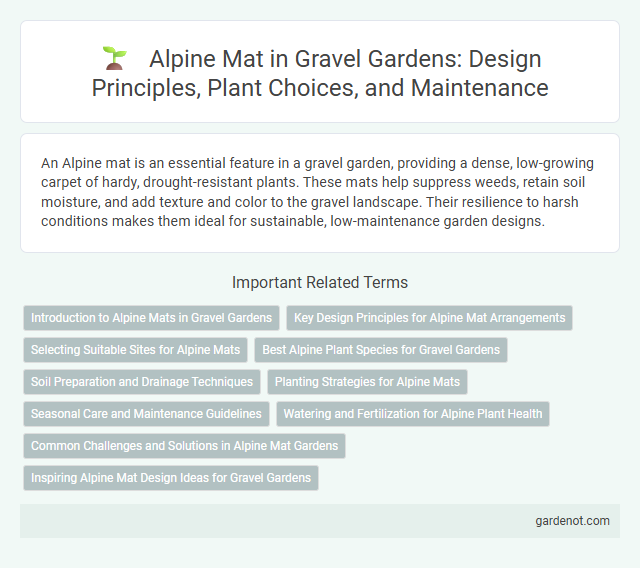An Alpine mat is an essential feature in a gravel garden, providing a dense, low-growing carpet of hardy, drought-resistant plants. These mats help suppress weeds, retain soil moisture, and add texture and color to the gravel landscape. Their resilience to harsh conditions makes them ideal for sustainable, low-maintenance garden designs.
Introduction to Alpine Mats in Gravel Gardens
Alpine mats are low-growing, hardy plants that thrive in gravel gardens, providing excellent ground cover with minimal maintenance. These mats consist of compact, drought-tolerant species such as Sedum, Saxifraga, and Phlox subulata, which can withstand harsh conditions while adding texture and color. Their ability to prevent soil erosion and retain moisture makes alpine mats ideal for creating sustainable, visually appealing gravel garden landscapes.
Key Design Principles for Alpine Mat Arrangements
Alpine mat arrangements emphasize low-growing, drought-resistant plants that thrive in well-drained, rocky substrates typical of gravel gardens. Key design principles include selecting species with varied textures and colors to create visual interest while ensuring proper spacing for air circulation and growth. Incorporating native alpine plants such as sedums, saxifrages, and sempervivums enhances resilience and complements the naturalistic, minimalist aesthetic of the gravel garden.
Selecting Suitable Sites for Alpine Mats
Alpine mats thrive in well-drained, rocky soils often found in gravel gardens with full sun exposure and minimal humidity. Selecting sites with proper drainage and protection from excessive moisture prevents root rot and promotes healthy growth. Avoid heavy clay soils and shaded areas to ensure optimal development of alpine mat vegetation.
Best Alpine Plant Species for Gravel Gardens
Sedum, Saxifraga, and Sempervivum are among the best alpine plant species for gravel gardens due to their drought tolerance and low maintenance needs. These hardy succulents thrive in well-drained, rocky soil and create attractive mats that prevent erosion while adding texture and color. Choosing species like Sedum album, Saxifraga oppositifolia, and Sempervivum tectorum ensures year-round interest and resilience in gravel garden settings.
Soil Preparation and Drainage Techniques
Alpine mats thrive in well-drained, gritty soil, making soil preparation crucial for a successful gravel garden. Incorporate sharp sand, grit, or small gravel to improve drainage and prevent waterlogging, which can damage delicate roots. Elevate planting areas slightly and consider installing a drainage layer of coarse stone beneath the soil to enhance water flow and create optimal conditions for alpine mat growth.
Planting Strategies for Alpine Mats
Alpine mat planting strategies involve selecting low-growing, drought-tolerant species such as sedums, saxifrages, and thyme to create dense, carpet-like vegetation that stabilizes gravel surfaces and conserves moisture. Positioning alpine mats in well-drained, sunny locations enhances root establishment and reduces fungal diseases, while incorporating a mix of evergreen and flowering plants ensures year-round visual interest and biodiversity. Regular pruning and controlled moisture management optimize growth, preventing invasive species from encroaching and maintaining the health of the gravel garden ecosystem.
Seasonal Care and Maintenance Guidelines
Alpine mats require seasonal care to maintain their health and appearance, including regular watering during dry periods and removing debris to prevent fungal growth. In spring, trim back dead foliage to encourage new growth and apply a balanced fertilizer to support blooming. During winter, protect the mat with a layer of mulch to insulate roots from frost damage and reduce water loss.
Watering and Fertilization for Alpine Plant Health
Alpine mats thrive in well-drained gravel gardens where consistent but minimal watering prevents root rot and mimics their natural mountainous habitat. Fertilization should be light with a balanced, slow-release formula high in phosphorus to encourage strong root development and vibrant blooms. Over-fertilizing can harm alpine plants, so applying nutrients sparingly during the growing season supports optimal health and resilience.
Common Challenges and Solutions in Alpine Mat Gardens
Alpine mats often face challenges such as poor drainage and soil compaction, which can lead to root rot and stunted growth in gravel gardens. Regularly incorporating coarse sand or gravel into the soil improves aeration and water flow, preventing these issues. Selecting drought-tolerant species with deep root systems also enhances resilience and ensures sustainable growth in alpine mat environments.
Inspiring Alpine Mat Design Ideas for Gravel Gardens
Alpine mats create a stunning, low-maintenance ground cover ideal for gravel gardens, combining drought tolerance with vibrant seasonal blooms. Popular choices such as Saxifraga and Aubrieta add texture and color, thriving in well-draining gravel beds while suppressing weeds effectively. Incorporating alpine mats enhances the visual appeal and ecological value of gravel gardens by attracting pollinators and requiring minimal irrigation.
Alpine mat Infographic

 gardenot.com
gardenot.com